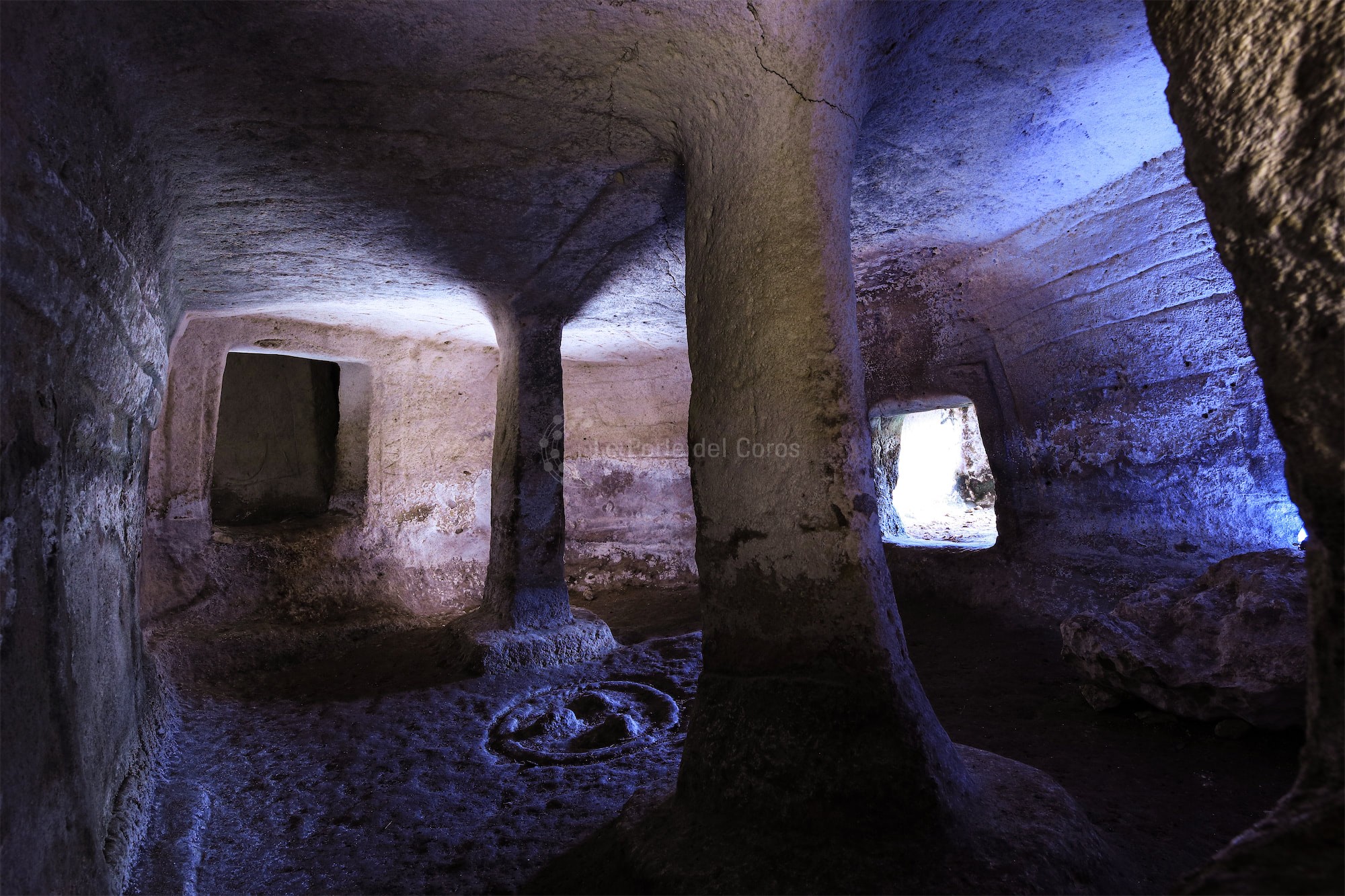
Ossi
Necropolis of Mesu e Montes
The necropolis of Mesu ‘e Montes is located along the steep southern slope of Mount Mamas and was excavated along a limestone wall that extends from east to west. It is made up of 18 multi-chambered domus de janas (tn* Neolithic tombs carved into rock called “houses of the fairies”): only 4 hypogea are located on low limestone rock ledges at the foot of the crag. The hypogea face the valley that separates Mount Mamas from Mount Mannu, connected by the road Pianu e’ Laccana, that leads to the foot of the rocky wall and divides the necropolis into two wings: 8 hypogea are found on the west side, 10 on the east.
The domus de janas are numbered from west to east: some copy the structural peculiarities of the Pre-nuragic huts, decorated with sacred symbols, linked to funerary rites. Among these, some are distinguished by their architectural and decorative features, such as Tombs I, II, V, and XIII. Of particular interest are Tombs III and XVI, which have a distinct architectural design: they have imposing stele-doorways carved from rock and are examples of Pre-nuragic hypogea which were reused in Nuragic times (tn* Bronze Age, 1800-1500 BC).
Among the 18 domus de janas of Mesu e’ Montes, 7 are decorated with elements that copy modified architectural features of civil dwellings, so as to underline the relationship between the hut and the tomb, in the religious beliefs of the Pre-nuragic world (tn* Sardinian prehistory dating from 4000 to 3000 BC, from the Palaeolithic to the middle Bronze Age). The hypogea have clear layouts thanks to the soft rock, typical of the territory where they are located. It is thought that other chambers were added to the initial simple scheme of one or two chambers, making symmetrical layouts with two coaxial chambers, where on the sides of the rear chamber, another two or more chambers are connected. It is the case of Tombs I and II, located on the western extremity of the necropolis, only 20 metres from one another. Both are made up of 12 chambers, organised in a T-shape plan, and modified by open chambers corresponding to the transversal axis. Tomb XIII has a longitudinal plan following an oblique axis consisting of 4 chambers, while Tomb V is an example of lateral development, in fact a little vestibule connects to the ante-chamber, that opens up laterally. The necropolis of Mesu e’ Montes displays typical decorations of Pre-nuragic huts. The walls of several hypogea are decorated with architectural motifs, carved or engraved, that seem to be inspired by the homes of the living, such as the base in relief at the bottom of the walls that seems to symbolise the stone walls of the huts. The uniqueness of the necropolis is shown by the fireplace carved in the centre of the floor of the main chamber of Mesu e’ Monte I, with a circular shape, marked by a ring in relief.
The domus de janas are numbered from west to east: some copy the structural peculiarities of the Pre-nuragic huts, decorated with sacred symbols, linked to funerary rites. Among these, some are distinguished by their architectural and decorative features, such as Tombs I, II, V, and XIII. Of particular interest are Tombs III and XVI, which have a distinct architectural design: they have imposing stele-doorways carved from rock and are examples of Pre-nuragic hypogea which were reused in Nuragic times (tn* Bronze Age, 1800-1500 BC).
Among the 18 domus de janas of Mesu e’ Montes, 7 are decorated with elements that copy modified architectural features of civil dwellings, so as to underline the relationship between the hut and the tomb, in the religious beliefs of the Pre-nuragic world (tn* Sardinian prehistory dating from 4000 to 3000 BC, from the Palaeolithic to the middle Bronze Age). The hypogea have clear layouts thanks to the soft rock, typical of the territory where they are located. It is thought that other chambers were added to the initial simple scheme of one or two chambers, making symmetrical layouts with two coaxial chambers, where on the sides of the rear chamber, another two or more chambers are connected. It is the case of Tombs I and II, located on the western extremity of the necropolis, only 20 metres from one another. Both are made up of 12 chambers, organised in a T-shape plan, and modified by open chambers corresponding to the transversal axis. Tomb XIII has a longitudinal plan following an oblique axis consisting of 4 chambers, while Tomb V is an example of lateral development, in fact a little vestibule connects to the ante-chamber, that opens up laterally. The necropolis of Mesu e’ Montes displays typical decorations of Pre-nuragic huts. The walls of several hypogea are decorated with architectural motifs, carved or engraved, that seem to be inspired by the homes of the living, such as the base in relief at the bottom of the walls that seems to symbolise the stone walls of the huts. The uniqueness of the necropolis is shown by the fireplace carved in the centre of the floor of the main chamber of Mesu e’ Monte I, with a circular shape, marked by a ring in relief.
Source: “The necropolis of Mesu e’ Montes” (in Italian), by Pina Maria Derudas, Sardegna Archeologica, guides and itineraries








